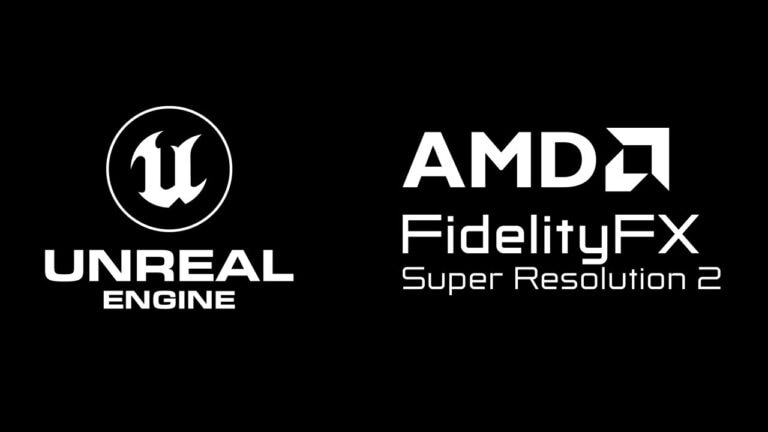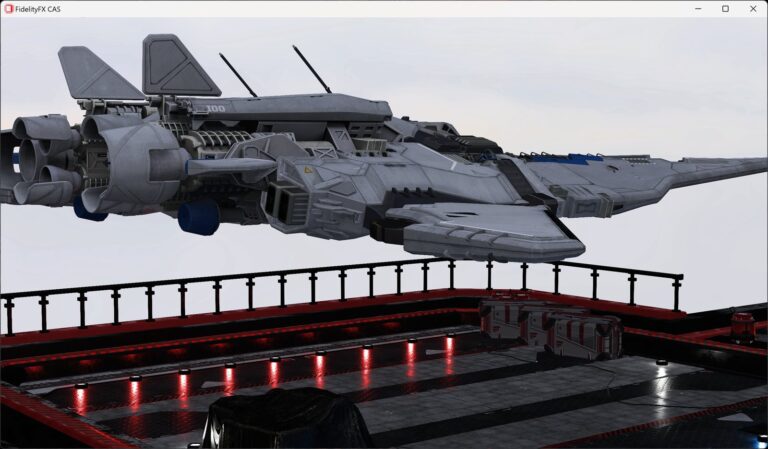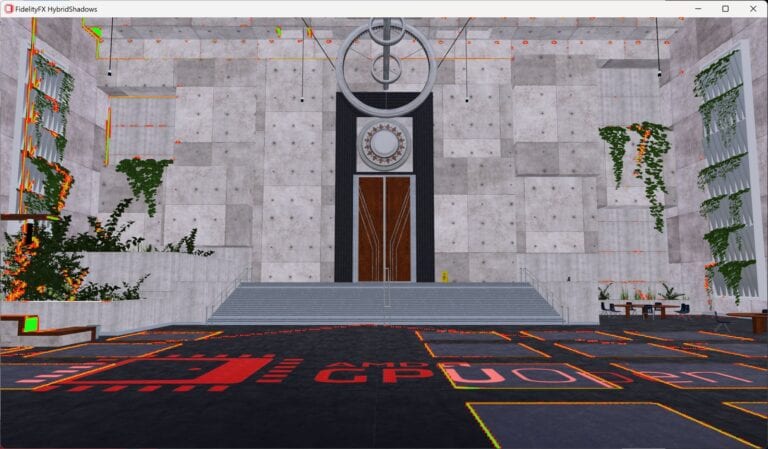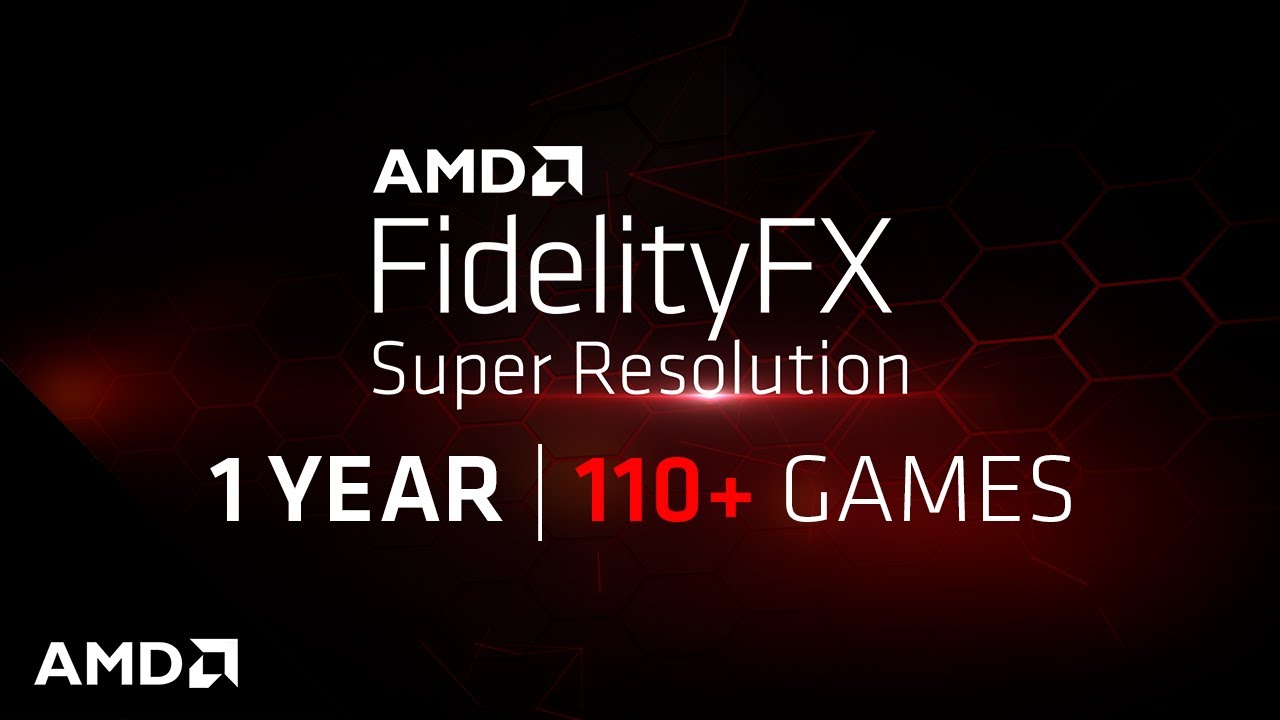
AMD FidelityFX™ Super Resolution 2 (FSR 2) technology is our brand-new open source temporal upscaling solution. FSR 2 uses cutting-edge temporal algorithms to reconstruct fine geometric and texture detail, producing anti-aliased output from aliased input.
FSR 2 technology has been developed from the ground up, and is the result of years of research from AMD. It has been designed to provide higher image quality compared to FSR 1, our original open source spatial upscaling solution launched in June 2021.
Note that FSR 1 can still be exposed as its own upscaling option in addition to FSR 2 in game titles. Both technologies have different characteristics which may be suitable for a wider range of platforms and user preferences. For example, our FSR 2 partner title DEATHLOOP exposes both!
Supports:
- DirectX® 12.
- Vulkan®.
- Unreal Engine 4.26/4.27 and Unreal Engine 5 as a plugin from the Unreal Marketplace.
AMD FSR 2 is therefore superseded by FSR 3. Developers only need to integrate FSR 3 to benefit from upscaling and frame generation. Please visit our dedicated FSR 3 page instead!
Download the latest version - v2.2.1
- FSR 2.2 API for integration.
- API documentation including quick start checklist – it is strongly recommended to consult this to ensure the best upscaling quality!
- Full C++ and HLSL source provided via a library.
- Samples provided for DirectX 12, and Vulkan.
Download the latest version - v2.2.2
- AMD FSR 3 supersedes AMD FSR 2 as it includes both upscaling and frame generation.
- FSR 2.2 API for integration.
- API documentation including quick start checklist – it is strongly recommended to consult this to ensure the best upscaling quality!
- Full C++ and HLSL source provided via a library.
- Samples provided for DirectX 12, and Vulkan.
For 2.2.2
- Now part of AMD FidelityFX SDK.
- Combined FSR 1 and FSR 2 samples into one sample for the AMD FidelityFX SDK.
For 2.2.1
- Documentation inconsistency in the fsr2.h comments.
- A luma internal resource was too large at creation.
- A resource needed to be cleared on first use to resolve corruption on some platforms.
- Potential for flashing lights to introduce corruption (fixed with a small change to the luma instability logic).
- Unreal Engine plugin updates include:
- Support for Unreal Engine 5.2.
- Added debug API checking/logging for Debug and Development builds.
- Fixed frameTimeDelta conversion.
- Fixed camera plane settings.
- Fixed an issue where a resource transition prevented resource cleanup in Unreal Engine 5.1.

AMD FidelityFX Super Resolution 2.2.1 hotfix!
Read about our improvements to AMD FidelityFX Super Resolution 2 with the FSR 2.2.1 hotfix.

Unreal Engine developer?
Don’t miss our guides below, which explain how get the most out of our Unreal Engine FSR 2 plugin

AMD FSR 2 UE plugin enhancements part 1: Intro & improving foliage appearance using the base pass
Discover one of several ways to improve upscaled foliage appearance in the first of this five part blog series on getting the most out of our FSR 2.1 Unreal Engine plugin.

How to use the AMD FidelityFX™ Super Resolution 2 (FSR 2) Unreal Engine plugin
Find out how to install and configure the AMD FidelityFX Super Resolution (FSR) 2 plugin for Unreal Engine 4.26/4.27 and UE5.

Guest blog by EBB Software: Integrating AMD FidelityFX™ Super Resolution 2 (FSR 2) into Scorn
In this guest post by EBB Software, learn how they integrated our FSR 2.1 plugin for Unreal Engine into their first title: Scorn

Xbox developer?
An example use of AMD FidelityFX Super Resolution 2.1 exists within the Xbox Game Development Kit samples.
Features
Temporal
Anti-aliasing
High image quality
No machine learning
Cross-platform
Open source
Temporal
- Delivers similar or better than native image quality using temporal data.
Anti-aliasing
- Includes high-quality anti-aliasing.
- FSR 2 replaces any TAA within the game frame.
High image quality
- Higher image quality than FSR 1 technology at all quality presets/resolutions.
- Different quality modes available.
- Dynamic Resolution Scaling supported.
No machine learning
- Does not require dedicated Machine Learning (ML) hardware.
- More platforms can benefit.
- Gives more control to cater to a range of different scenarios.
- Better ability to optimize.
Cross-platform
- Boosts framerates in supported games.
- Wide range of products and platforms, both AMD and select competitors.
Open source
- Available here on GPUOpen under an MIT license.
How it works
General integration
As with FSR 1, FSR 2 is open source, via the MIT license. Integration should be easy, via the intuitive, flexible API. FSR 2 requires three buffers (depth, color, and velocity) be provided at render resolution, with optional reactive mask and exposure required for the best possible quality.
Bonus tip: You’ll find an easier integration for FSR 2 technology into games that already have a temporal upscaling rendering path.
Render resolution
Presentation resolution

Where to integrate AMD FidelityFX Super Resolution 2 in a frame
Compared to FSR 1, FSR 2 is earlier in the frame pipeline.
- As it replaces TAA, any post processing that requires anti-aliased input will need to be post-upscale.
- Any post-processing effect that requires the depth buffer will need to be pre-upscale.
Render resolution
Presentation resolution

No machine learning?
Machine Learning (ML) is not a prerequisite to achieving good quality image upscaling. Often, ML-based real-time temporal upscalers use the model learned solely to decide how to combine previous history samples to generate the upscaled image: there is typically no actual generation of new features from recognizing shapes or objects in the scene. AMD engineers leveraged their world-class expertise to research, develop and optimize a set of advanced hand-coded algorithms that map such relationships from the source and its historical data to upscaled resolution.
The FidelityFX Super Resolution 2 analytical approach can provide advantages compared to ML solutions, such as more control to cater to a range of different scenarios, and a better ability to optimize. Above all, not requiring dedicated ML hardware means that more platforms can benefit, and more gamers will be able to experience FSR 2.
How long to integrate?
Integration time will vary from title to title.

Or any of our AMD FidelityFX effects, including FSR 1?
Please take a look at our AMD FidelityFX Naming Guidelines for advice on presenting FSR 2 in your game UI, and to obtain AMD FidelityFX™ logo assets.
FSR 2 quality modes
There are four different quality modes: Quality, Balanced, Performance, with Ultra Performance as an optional mode. These vary the amount of scaling to apply to the source image, depending on the quality/performance ratio desired.
There’s also:
- Support for Dynamic Resolution Scaling, whereby source resolution is determined by a fixed performance budget to achieve a minimum frame rate.
- Optional configurable RCAS sharpening to help emphasize pixel detail.
- We encourage developers to provide a sharpness slider to allow end users to set the sharpening amount according to their preferences.

* Optional
FSR 2 performance
AMD FidelityFX Super Resolution 2 is designed to boost framerates in supported games. As an advanced temporal upscaling solution, it will be more demanding on graphics cards than a spatial upscaling solution like FSR 1. Gaming experience may vary, depending on specific system specifications, the requirements of individual games that support FSR 2, and the target resolution. Nevertheless, gamers may be able to have a good upscaling experience on lower performing or older GPUs.
The table below lists the upper bound of performance overhead of FSR 2 in quality and performance modes for different classes of AMD GPUs and target resolutions.
Quality mode
- Includes auto-exposure, no sharpening.
| FSR 2 TARGET RESOLUTION | AMD RADEON™ RX 6800XT | AMD RADEON™ RX 6700XT | AMD RADEON™ RX 5700XT |
|---|---|---|---|
| 4K | < 1.3ms |
< 1.9ms |
< 2.4ms |
| 1440p | < 0.6ms |
< 0.8ms |
< 1.1ms |
| 1080p | < 0.3ms |
< 0.5ms |
< 0.6ms |
Performance mode
- Includes auto-exposure, no sharpening.
| FSR 2 TARGET RESOLUTION | AMD RADEON™ RX 6800XT | AMD RADEON™ RX 6700XT | AMD RADEON™ RX 5700XT |
|---|---|---|---|
| 4K | < 1.1ms |
< 1.6ms |
< 2.0ms |
| 1440p | < 0.5ms |
< 0.7ms |
< 0.9ms |
| 1080p | < 0.3ms |
< 0.4ms |
< 0.5ms |
For both quality and performance mode tables:
- AMD Ryzen™ 9 5900X @ 3.70GHz.
- AMD Radeon™ Adrenalin 22.5.2.
- GPU as described in tables.
- Windows 11 Pro 64-bit V21H2
- DirectX 12
- Direct3D version 9.14.10.01521
Comparison images
The comparison image below (FSR 2.0) uses a 1280 x 600px 1:1 crop (zoom in if needed) of a 4K frame from the new Sponza scene from Intel®.
Note: All the embedded images shown below are JPEGs saved with minimal compression so this web page loads much faster. If you would like to view the original PNGs (including other quality modes) these are available under every image, along with links to other scenes not shown on this page. You can also download every image linked to below in this one big ZIP:
4K comparison
- Sharpening applied to FSR 2 image


1440p comparison
Our engineers have been working closely with engineers at Arkane Lyon to bring FSR 2 to DEATHLOOP™. We’re excited to bring you these lower resolution comparison screenshots. You can read more about these images on a recent AMD blog.
The two sets of comparison images¹ below are 1280 x 600px 1:1 crops (zoom in if needed) of different resolution frames taken from a development build of DEATHLOOP.
Please note: At low resolutions (under 720p), DEATHLOOP can sometimes not render certain small objects at far distances, such as the light bulbs shown in the 1080p comparison images. When targeting 1080p output, the FSR 2 internal render resolution is 1280 x 720 or below, which results in the missing objects shown here — this issue is therefore not related to FSR 2.


1080p comparison


Take a look at our latest video (September 2022) to see FSR 2.1 in action!
Find out more on our YouTube channel
FidelityFX Super Resolution 2
AMD FidelityFX Super Resolution 2 is AMD’s next generation upscaling technology, delivering similar or better than native image quality using temporal data.
In this talk, our engineers will first discuss how this new technology is able to significantly increase image quality, diving into some of the algorithmic aspects which enable FSR 2 to reconstruct upscaled fine details from low-resolution input images. Then, multiple optimizations implemented during development will be presented, including how FSR 2 manages cross-platform performance.
Lastly, game developers will learn valuable insight on how to integrate FSR 2 to allow for the highest visual quality upscaling at optimal performance.
Temporal upscaling: Past, present, and future
This presentation provides a deep dive into temporal upscaling, describing how different parts of the algorithm work together to generate the final image and what techniques are used in FSR to mitigate various common artifacts.
The presentation will also cover lessons learned from integrating temporal upscaling into various AAA games and will suggest best practices for integration, from quickly getting a working prototype to full integration into your engine using all bells and whistles.
Finally, this presentation will discuss the evolution of FSR 2 since initial release, as several internal features required a significant redesign due to special requirements of various titles.
Developers with games which support FSR 2 now or in the future[Full list of titles here]
























Watch our 1 Year of AMD FidelityFX Super Resolution video
We're very impressed with AMD FidelityFx Super Resolution 2.0. With support for a similar method already in place it only took a few hours to integrate and produces significantly sharper results than our existing TAA upscaling.
We’ve been aggressively pursuing the modernization of our game engine and evaluating options to improve the gaming experience for as many customers as possible. EVE Online supports a wide range of hardware configurations and this is why AMD FidelityFX Super Resolution caught our eye.
After initial investigations, we’re excited to improve the framerate with FSR and are already planning an upgrade to FSR 2.0.
Related GPUOpen content

AMD FidelityFX™ Super Resolution 1 (FSR 1)
AMD FidelityFX Super Resolution (FSR) is our open-source, high-quality, high-performance upscaling solution.

AMD FidelityFX™ – Testimonials
Find out what developers are saying about AMD FidelityFX.
All part of the FidelityFX SDK!

AMD FidelityFX™ SDK
The AMD FidelityFX SDK is our easy-to-integrate solution for developers looking to include FidelityFX features into their games.
Don't miss our other effects

AMD FidelityFX™ Blur
AMD FidelityFX Blur is an AMD RDNA™ architecture optimized collection of blur kernels from 3×3 up to 21×21.

AMD FidelityFX™ Combined Adaptive Compute Ambient Occlusion (CACAO)
AMD FidelityFX Combined Adaptive Compute Ambient Occlusion (CACAO) is an AMD RDNA™ architecture optimized implementation of ambient occlusion.

AMD FidelityFX™ Contrast Adaptive Sharpening (CAS)
AMD FidelityFX Contrast Adaptive Sharpening (CAS) provides a mixed ability to sharpen and optionally scale an image.

AMD FidelityFX™ Denoiser
AMD FidelityFX Denoiser is a set of denoising compute shaders which remove artefacts from reflection and shadow rendering.

AMD FidelityFX™ Depth of Field (DoF)
AMD FidelityFX Depth of Field is an AMD RDNA™-architecture optimized implementation of physically correct camera-based depth of field.

AMD FidelityFX™ Hybrid Shadows sample
This sample demonstrates how to combine ray traced shadows and rasterized shadow maps together to achieve high quality and performance.

AMD FidelityFX™ Hybrid Stochastic Reflections sample
This sample shows how to combine AMD FidelityFX Stochastic Screen Space Reflections (SSSR) with ray tracing in order to create high quality reflections.

AMD FidelityFX™ Lens
AMD FidelityFX Lens is an AMD RDNA™ architecture optimized implementation of some of gaming’s most used post-processing effects.

AMD FidelityFX™ Luminance Preserving Mapper (HDR Mapper)
AMD FidelityFX LPM provides an open-source library to easily integrate HDR and wide gamut tone and gamut mapping into your game.

AMD FidelityFX™ Naming Guidelines in Game Titles
A set of guidelines for developers on how to present options in the game’s user interface to enable/disable AMD FidelityFX Effects.

AMD FidelityFX™ Parallel Sort
AMD FidelityFX Parallel Sort makes sorting data on the GPU quicker, and easier. Use our SM6.0 compute shaders to get your data in order.

AMD FidelityFX™ Single Pass Downsampler (SPD)
AMD FidelityFX Single Pass Downsampler (SPD) provides an AMD RDNA™ architecture optimized solution for generating up to 12 MIP levels of a texture.

AMD FidelityFX™ Stochastic Screen Space Reflections (SSSR)
The AMD FidelityFX SSSR effect provides an open-source library to easily integrate stochastic screen space reflections into your game.

AMD FidelityFX™ Super Resolution 1 (FSR 1)
AMD FidelityFX Super Resolution (FSR) is our open-source, high-quality, high-performance upscaling solution.

AMD FidelityFX™ Super Resolution 3 (FSR 3)
Discover frame generation with AMD FidelityFX™ Super Resolution 3, and get the source code and documentation!

AMD FidelityFX™ Variable Shading
AMD FidelityFX Variable Shading drives Variable Rate Shading into your game.

Radeon™ Cauldron Framework
Radeon Cauldron is our open-source experimentation framework for DirectX®12 and Vulkan®, provided in the AMD FidelityFX SDK.

TressFX
The TressFX library is AMD’s hair/fur rendering and simulation technology. TressFX is designed to use the GPU to simulate and render high-quality, realistic hair and fur.
1.DEATHLOOP screenshot game settings: “Ultra” graphics preset, DirectX® 12. AMD Radeon™ RX 6900 XT with AMD Smart Access Memory™ and FSR 2.0 “Quality”, “Balanced”, and “Performance” modes enabled (driver: AMD Radeon™ Software Adrenalin 22.2.1), AMD Ryzen™ Threadripper 3970X, 128GB DDR4 RAM, and Windows® 10 Pro Results may vary.
Deathloop © 2022 ZeniMax Media Inc. Developed in association with Arkane Studios. Deathloop, Arkane, Bethesda, Bethesda Softworks, ZeniMax and related logos are registered trademarks or trademarks of ZeniMax Media Inc. in the U.S. and/or other countries. All Rights Reserved.
Trailer: DEATHLOOP game settings: “Ultra” graphics preset with raytracing, DirectX® 12. AMD Radeon™ RX 6900 XT with AMD Smart Access Memory™ and FSR 2.0 “Quality” and “Performance” modes enabled (driver: AMD Radeon™ Software Adrenalin 21.50-220210a), AMD Ryzen™ 9 5900X, 16GB DDR4-3200 RAM, Qogir AM4 motherboard, and Windows® 10 Pro May 2020 update (19041.508). Results may vary.
© 2022 Advanced Micro Devices, Inc. All rights reserved. AMD, the AMD Arrow logo, FidelityFX, Radeon, Ryzen, and combinations thereof are trademarks of Advanced Micro Devices, Inc. Other product names used in this publication are for identification purposes only and may be trademarks of their respective owners.









